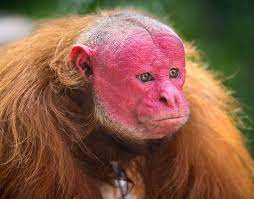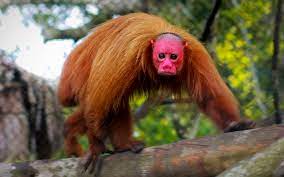Deep within the lush and diverse Amazon rainforest resides a unique and captivating primate known as the Kel Uakari. With its distinct bald head and vibrant red face, the Kel Uakari stands out among its fellow primates. In this blog, we will explore the fascinating world of the Kel Uakari, including its physical characteristics, habitat, social behavior, and the conservation challenges it faces in the wild.

Physical Characteristics: The Kel Uakari (Cacajao calvus) is a medium-sized primate with a stocky build and a short tail. However, what truly sets the Kel Uakari apart is its unique facial features. It has a hairless head with a prominent crest on top, which gives it the appearance of being bald. The fur on its body varies in color, ranging from dark brown to bright red or even orange. The vibrant red face is a distinguishing characteristic and is thought to play a role in communication among group members.
Habitat and Distribution: The Kel Uakari is native to the Amazon rainforest, specifically the lowland forests of Brazil, Colombia, and Peru. These primates are highly adapted to life in flooded regions and are often found near riverbanks and flooded forests. They are primarily arboreal, spending much of their time in the trees, where they search for fruits, seeds, and other plant material to eat.
Social Behavior: Kel Uakaris are highly social creatures and live in groups known as troops. Troops can consist of anywhere from 20 to 100 individuals, with a mix of males, females, and offspring. Within these groups, there is a complex social structure, with dominant males leading the troop and playing a vital role in protecting their territory. They communicate using a variety of vocalizations and body postures, allowing them to coordinate activities and maintain group cohesion.
Reproduction and Parenting: Breeding in Kel Uakaris typically occurs during the rainy season when food is abundant. After a gestation period of around five months, females give birth to a single offspring. Infant Kel Uakaris are born with a full coat of fur and cling tightly to their mother’s belly. Mothers are highly attentive and protective of their young, and other group members also participate in caring for and playing with the infants.
Conservation Challenges: Like many other species in the Amazon rainforest, Kel Uakaris face significant conservation challenges. Deforestation due to logging, agriculture, and other human activities is a major threat to their habitat. Additionally, they are hunted for their meat and captured for the pet trade, further impacting their populations. As a result, the International Union for Conservation of Nature (IUCN) lists the Kel Uakari as a vulnerable species.
Conservation Efforts: Efforts are underway to protect the Amazon rainforest and the incredible biodiversity it harbors, including the Kel Uakari. Various organizations and conservation groups are working to establish protected areas, promote sustainable land-use practices, and raise awareness about the importance of preserving this unique primate species.
Conclusion: The Kel Uakari, with its distinctive appearance and intriguing social behaviors, offers a glimpse into the remarkable diversity of life in the Amazon rainforest. As we strive to conserve this delicate ecosystem, it is essential to recognize the value of every species, including the Kel Uakari, and work together to ensure their survival for generations to come. By supporting conservation efforts and respecting the natural world, we can protect the Kel Uakari and the many other incredible species that call the Amazon rainforest home.



















Add Comment